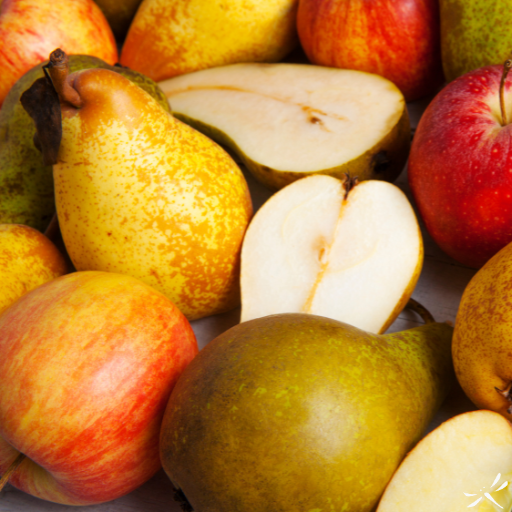The current apple and pear harvest season is defined by a dichotomy of abundance and adversity. In North America, a projected large apple crop, led by a record harvest in Washington State, is colliding with market oversupply, stagnant domestic demand, and crippling cost increases. This has created a critical financial squeeze, forcing some growers to consider drastic measures like orchard removal.
Europe, by contrast, faces a more fragmented picture. While some regions like Germany and Poland anticipate positive apple harvests, others, particularly France and Italy, are grappling with significant pear production declines due to localized weather events and pest pressure.
Across both continents, the universal challenges of rising labor costs, climate volatility, and the need for greater efficiency and traceability are driving a new era of strategic adaptation, where technology is no longer an option but a necessity for survival. In this blog post, we have compiled the apple and pear industry projections from North America and Europe we have been following this season.

North American: The Challenge of Abundance
This section will delve into the complex landscape of the 2025 North American apple and pear harvest, where the promise of a large harvest is shadowed by a perfect storm of economic and market pressures.
A Record Crop Amidst a Crisis
The U.S. Apple Association (USApple) forecasts a large apple crop of approximately 278.5 million bushels for the 2025-26 season, an increase of 1.3% from the previous season and 3.6% above the five-year average. This initial estimate, while slightly lower than the USDA's projection of 290.1 million bushels, points to a robust harvest with high potential. Washington State is projected to lead the charge with a record-setting crop of over 180 million bushels, a 1.1% increase year-over-year, buoyed by a mild summer and ideal weather.
This abundance, however, is a double-edged sword. Industry leaders, such as West Mathison, president of Stemilt Growers, are sounding the alarm, stating that the industry does not have a demand problem, but rather a "supply problem," which he considers a management issue. With the current expected crop size, the market has about six weeks more of inventory than it needs.
This market imbalance is compounded by stagnant domestic consumption and a shift in the export market, where a strong U.S. dollar has made it difficult for Washington growers to compete. Since 2014, foreign customers have lost 25% of their purchasing power, and the farmgate breakeven cost for some orchards has effectively doubled.
The consequence of this confluence of factors is that an increase in production volume does not correlate with an increase in profitability under current market conditions. The oversupply forces down farm-gate prices, leaving growers squeezed between low returns and skyrocketing costs for labor, fertilizer, and fuel. This situation is leading to a critical moment for the industry, where Mathison anticipates a "cataclysmic event" rather than a slow erosion, with large-scale orchard removal expected to begin after the 2025 crop year.
Regional Variances and Varietal Shifts
While Washington dominates, other key regions are also contributing to the national crop. Michigan's production is up 10% to about 30 million bushels, and Oregon is up 40% to 3.9 million bushels. Conversely, some regions are seeing significant drops, such as Virginia, which is down 50% to 2.75 million bushels. The Pacific Northwest is also expected to have a comeback year for pears following a hard season in 2024.
In Canada, Quebec's robust crop, driven by timely rainfall and minimal hail damage, is set to increase national apple production by 5%, a significant recovery from previous frost challenges. This increase will partially offset an early projected 9% decline in Canadian pear production, which has been impacted by extreme cold in British Columbia.
Rising Costs and Shifting Markets
The financial squeeze on growers is not just due to low prices, but also to "skyrocketing labor costs" and other inputs. Labor costs can represent nearly 50% of a farm's overall expenses, with the ever-increasing Adverse Effect Wage Rates (AEWR) and associated H-2A program fees posing a serious threat to profitability. This financial pressure is compelling some growers to stop cultivating less profitable or more labor-intensive crops. The financial distress is a symptom of a larger structural problem: the traditional model of high-labor, high-volume production is no longer sustainable.
The data explicitly states that growers are being "taxed and regulated out of existence" by labor costs. The logical response, as documented in the research, is a shift towards automation (e.g., harvesting, spraying, grading) and cultivation of less labor-intensive crops. The labor crisis is a powerful, non-negotiable driver of technological adoption and a fundamental restructuring of the industry. The industry is not just adapting; it is being forced to evolve. The rising costs of production, combined with the market's refusal to bear these costs through higher prices, means the only way to restore profitability is through internal efficiency gains.

European: Navigating Climate and Market Shifts
This section will explore the fragmented, region-specific outcomes of the 2025 European harvest, where climate variability is a primary determinant of success and failure.
Regional Successes and Subdued Totals in Apples
The overall EU apple production forecast is for a stable 10.5 million tons, but this figure is 7.5% lower than the average over the past three and five years. Germany stands out with a projected harvest of over 1 million tons for the first time since 2022, a nearly 16% increase from 2024, credited to favorable weather conditions including mild temperatures during flowering and an absence of frost or hail. Poland, the largest apple producer in the region, expects a modest increase of 3% to over 3.3 million tons, a rebound from a more challenging 2024 season. The European market continues to see a decline in the dominance of traditional varieties like Golden Delicious and Idared, with Gala and club varieties gaining prominence, particularly in Western European countries.
High Demand and Supply Shortages for Pears
The European pear harvest tells a story of significant regional disparities. Italy is facing a severe 24.7% decline in production to 302,000 tonnes, while France is expected to see a 7% decrease in production, a result of significant fruit drop caused by rain and health problems like scab. In stark contrast, other major producers are forecasting higher volumes. Belgium, the Netherlands, Spain, and Poland all expect increases, with Belgium's production set to increase by 32.1% to 355,000 tonnes.
The fragmented nature of the European pear harvest is a direct consequence of localized climate events. Rain during fruit set in France and significant crop losses in Italy directly impact overall EU supply, despite positive outcomes elsewhere. This creates market instability, as the total EU production remains below its long-term average.
The consequence is an "undersupplied market" with low stocks and high prices, leading to intense competition among suppliers in the coming months. This demonstrates how micro-level climate issues can have macro-level market implications, making long-term planning and risk management critically important.
Climate Volatility and Evolving Consumer Demands
Beyond the harvest numbers, European growers are universally facing challenges related to climate variability, including biosecurity threats, labor shortages, and rising costs. The modern retail customer is also becoming more aware and is looking for fruit that is free from, or contains minimal amounts of, chemical plant protection product residues. This is creating additional pressure on growers to invest in new practices and achieve certifications like GlobalG.A.P. and GRASP.

Overarching Industry Challenges & The Path Forward
This section will highlight the shared challenges across both continents and discuss how the industry is adapting, with a focus on the essential role of technology.
The Cross-Continental Labor Crisis
Both North America and Europe are grappling with significant labor issues. In the U.S., it's the cost and regulatory burden of H-2A labor. In Europe, it's a general shortage of labor and rising costs. This shared challenge has made automation and robotization a growing area of interest for growers globally.
The data from both continents points to a common conclusion: the traditional manual labor model is no longer financially viable. The crisis is not just about labor availability but about cost, making investments in automation and efficiency-focused software not a luxury, but a survival strategy. The rising costs of production, combined with the market's refusal to bear these costs through higher prices, means the only way to restore profitability is through internal efficiency gains. This provides a direct and powerful reason for growers to adopt agtech solutions.
Long-Term Strategic Adaptation to Climate Challenges
Beyond the short-term harvest impacts, long-term climate trends pose an existential threat. A Stanford study projects that rising global temperatures will cut global crop yields by 8% by 2050, even with adaptation. Intriguingly, while U.S. "breadbaskets" may suffer, cooler regions in Canada and Russia could benefit, and temperate regions like North America and Europe could even see an increase in suitable crop diversity.
The geography of agriculture is shifting. While this presents a threat to established growing regions, it also creates an opportunity for diversification. The industry's response will involve not just adapting farming practices, but also strategically re-evaluating where and what to grow. The challenges of water management, biosecurity threats, and weather unpredictability will demand a new level of precision and foresight, moving from reactive to proactive management.
The Role of Technology
The analysis reveals a powerful link between the challenges facing the pome fruit industry and the solutions offered by modern agricultural technology. As growers struggle with low prices and high costs, the only viable path to profitability is through increased efficiency and precision. This is where farm management software, like Croptracker, becomes essential. Croptracker offers a complete suite of modules that address the most pressing issues identified in the research.
For example, the Punch Clock module provides a vital tool for managing and optimizing one of the highest farm expenses, while the Spray and Production Practice modules help growers meet the growing consumer demand for sustainable practices and minimal chemical residues. Crucially, the Harvest Quality Vision technology offers real-time empirical analysis of harvested apples and pears, allowing growers to make informed decisions about which fruit to harvest and what to pack, directly addressing the issue of oversupply of low-quality fruit that depresses market prices. The entire system is designed with traceability, audits, and recordkeeping in mind, which is no longer optional for serious business in today's market.
Strategic Recommendations

The 2025 season reveals a pome fruit industry at a crossroads. North America's record crop is a symptom of a deep-seated economic crisis, driven by high costs and market oversupply. Europe's season is a story of climate-driven regional fragmentation. Both are facing the dual pressures of rising costs and a volatile environment.The path forward requires a fundamental shift in strategy. Growers must prioritize efficiency over volume, with a focus on producing high-quality fruit that meets consumer demand.
Survival necessitates strategic investments in automation, diversified varietal portfolios, and farm management software that provides the data and insights needed to make informed decisions and remain profitable in a turbulent market. The challenges of 2025 are not just seasonal setbacks but are accelerating a permanent transformation of the apple and pear industry towards a more resilient, data-driven, and technologically advanced future.

